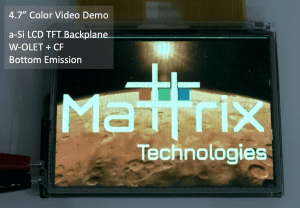Mattrix Technologies has developed the world's first AMOLED display built on an LCD backplane GAINESVILLE, FL, UNITED STATES, August 12, 2021 /EINPre
GAINESVILLE, FL, UNITED STATES, August 12, 2021 /EINPresswire.com/ — Mattrix Technologies has demonstrated a new active-matrix OLED display prototype exploiting technology typically used in LCD manufacturing. The innovation behind the demo promises to dramatically reduce the cost of OLED manufacturing and improve the visual quality of high-end displays. The proof-of-concept display was designed and built in collaboration with JSR Corporation, a key supplier of fine electronic materials to the display industry and an investor in Mattrix Technologies.
The demo is the world’s first White-OLED (WOLED) display to use the amorphous-Silicon backplane technology commonly used in LCD-TVs. It has long been assumed impossible to use amorphous-Silicon transistors to power OLED pixels, so this may prove to be a major step forward in reducing manufacturing complexity and improving yields. The implication is that existing (and often fully depreciated) LCD-TV factories could now be readily converted to produce more advanced WOLED TVs – saving hundreds of millions of dollars in capex costs per fab line. Mattrix estimates that the technology could reduce costs by as much as 25% on a per square meter basis, a huge savings for an industry that regularly reports single-digit margins.
A video of the prototype and technical information can be found at Mattrix's website.
The prototype panel is based on the company’s proprietary vertical, organic light-emitting transistor (VOLET) pixel technology. The 4.7” full-color, 85ppi, active-matrix display uses the white OLED plus color filter design that is common in OLED TV manufacturing, while the backplane is an unmodified amorphous-Silicon LCD backplane from a third-party supplier. In addition to simplifying the manufacturing process, the new design allows for more of the pixel real-estate to be dedicated to light-emission, meaning brighter displays, and longer lasting products.
“We are thrilled to share this breakthrough with the industry and clear a path for LCD panel manufacturers to join in the OLED revolution. We have a tremendous team, industry-leading collaborators, and our technology addresses the fundamental issue with OLEDs today: their high cost,” says Mattrix Technologies CEO and founder, Max Lemaitre.
Mattrix has recently begun demonstrating their displays to panel manufactures and industry suppliers. They plan to publicly demo the latest prototype at the iMiD 2021 conference, in Seoul, South Korea, August 25-27th. Mattrix has also launched a new website – www.mattrix.com – to showcase the impact of this new technology for all display applications.
Mattrix Technologies spun out of the University of Florida in 2018 to commercialize the VOLET technology. Mattrix Technologies’ business is: 1) the licensing of display technology and manufacturing process IP to TV and Smartphone panel makers, 2) providing panel and driver circuitry design services, and 3) selling advanced materials.
About Mattrix Technologies
Founded in 2018, Mattrix Technologies is a semiconductor device company developing a breakthrough pixel architecture for flat-panel displays. The company has pioneered its revolutionary OLET (organic light emitting transistor) technology to enable the cost-effective production of large-area displays.
OLET is a new paradigm for emissive displays that solves the backplane challenges that have limited the adoption of AMOLED displays. At the heart of this breakthrough is a proprietary pixel architecture that combines the drive transistor, storage capacitor and light emitting layers into a single element. This enables a full-aperture, bottom emission display that simplifies the manufacturing process, increases product lifetime and panel brightness.
For more information please visit www.mattrix.com
Media Inquiries: info@mattrix.com
Max Lemaitre
Mattrix Technologies
+1 847-269-3692
info@mattrix.com
Visit us on social media:
LinkedIn
![]()
